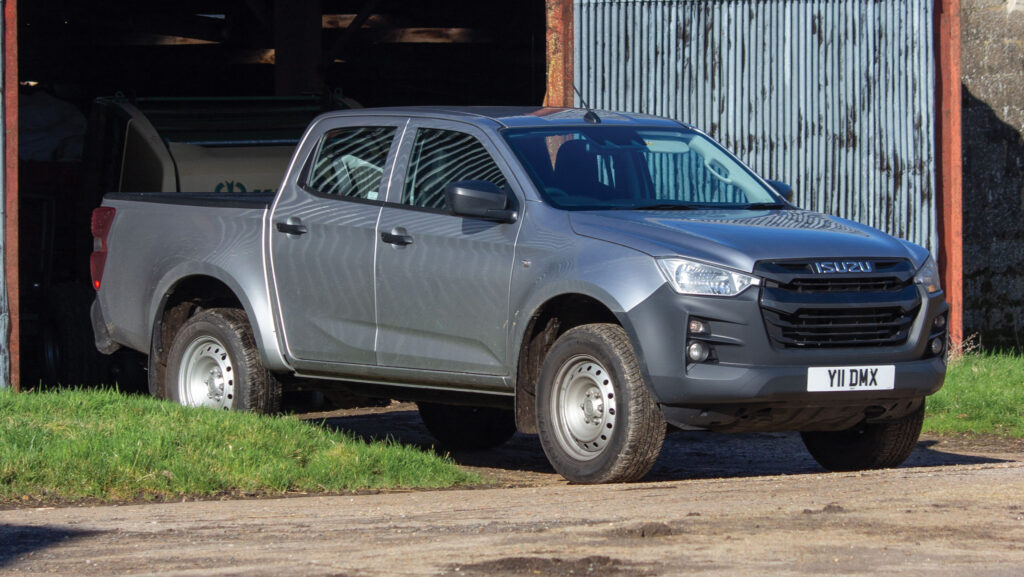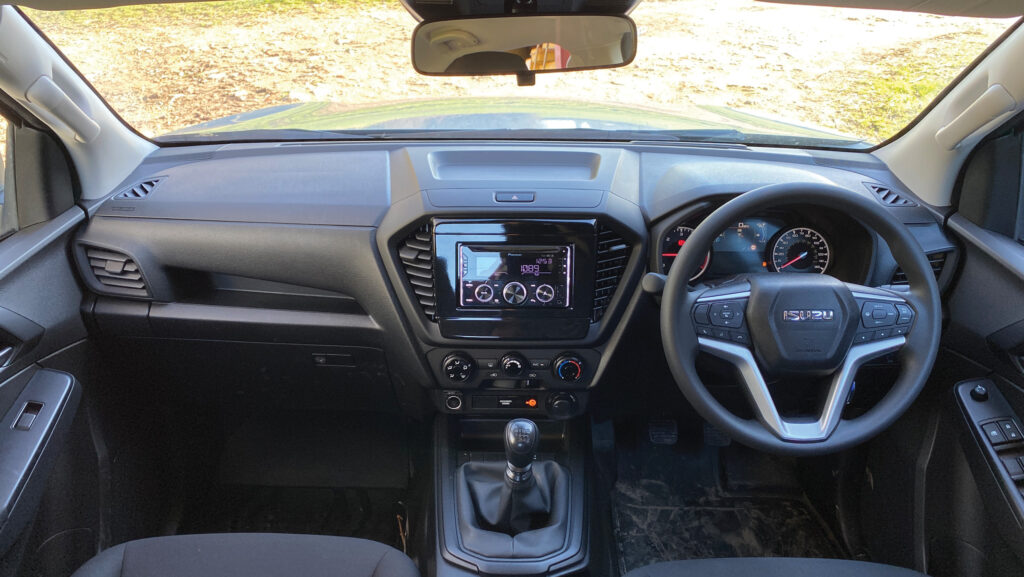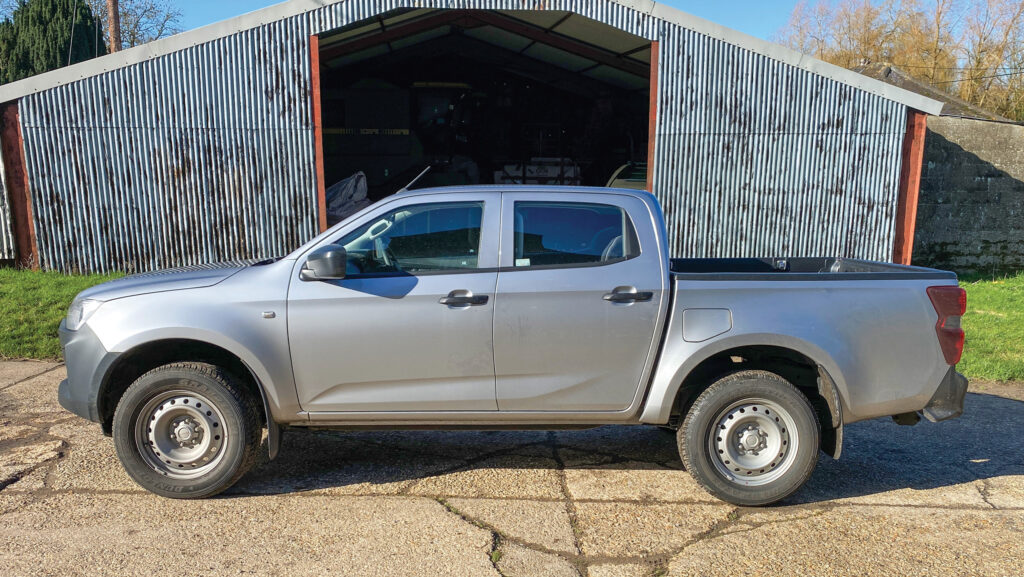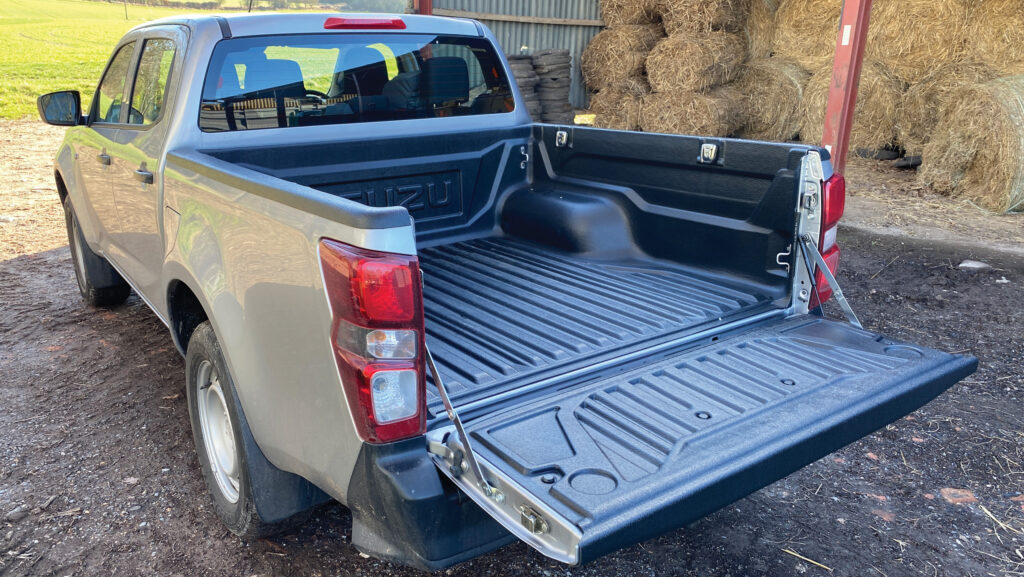On test: Bog-basic Isuzu D-Max Utility isn’t cheap enough
 © MAG/Oliver Mark
© MAG/Oliver Mark If you’re the type of penny-pincher to wear hole-ridden pants, conjure two brews from a single teabag, and keep your house thermostat sub-double digits then, as new vehicles go, Isuzu’s D-Max Utility might just be the one.
Devoid of life’s frills and fripperies, there’s not a whiff of opulence about this most ruthlessly basic of pickups, save for a DAB stereo and some naff digitisation between the dash binnacles.
Buyers willing to put up with its vices – bland exterior, spartan interior and asthmatic engine – will be rewarded with decent value for money relative to the plusher models.
See also: On test: Base-spec and bestselling Ford Ranger pickups face off
That’s because, unlike Ford, VW and Toyota, Isuzu’s five-strong range contains nothing bigger or more formidable than the standard 1.9-litre, 164hp block, and nothing slicker than a six-speed gearbox.
As a result, the £10,000 that splits base Utility and range-topping V-Cross purely covers touchscreens, fancier seating, parking-related paraphernalia and the other usual niceties.
Even the faintly ridiculous Arctic Trucks AT35 (north of £60,000) gets the same means of propulsion and relatively rudimentary six-cogger.
All the more reason, then, to stick with the Utility which, on the outside, screams workhorse with its 18in steel wheels, black plastic trim and distinct lack of chromification.
It comes in single-, extended- and double-cab versions, and it’s the latter we’re concentrating on here.
Powertrain problem
The 1.9-litre engine has been a moot point among potential buyers since it replaced the old, and somewhat unrefined, 2.5 seven years ago.
Unlike its peers, pickup specialist Isuzu is without any small hybrid and electric cars against which it could offset carbon emissions.
This means it has no choice but to saddle the D-Max with the modestly sized but economical four-potter that is unlikely to strike fear in the skin of too many rice puddings.
It was passable at the time of its launch, but has since been left behind as others have improved.
That’s particularly the case with the similarly priced Ford Ranger XL featured in March’s Country Car.
At 12.7sec, its best 0-62mph attempt ain’t quick.
Though it is generally fine on the flat, the engine’s dump-truck grumble fails to translate into meaningful pulling power, so it can be found labouring in the face of a reasonable incline.
Plenty of gearbox action is required to maintain the punch delivered as the turbo kicks in; get lazy and revs gradually drain away and seldom return until well beyond the crest.
Finding the sweet spot, at about 2,500rpm, will be a necessity with a trailer latched to the towbar.

© MAG/Oliver Mark
Transmission
The transmission is equally agricultural, with the six-speed manual running through a long, rubbery gate.
Cruise control is standard – one of the few perks – and there is the option of upgrading to an automatic gearbox for about £1,500, something roughly 40% of buyers take up.
First gear is short, which is great for towing but, when without a load, it can be smoother to pull off in second if the terrain allows.
Despite its foibles, the Utility does have plenty going for it. For one, it’s seriously frugal, to the tune of 36.5mpg when punting along at a steady 65mph. That knocks the Ranger XL out the park.
Part of that is likely down to its modest weight, and this brings another advantage – as it sneaks below 2,040kg unladen, DVLA classifies it a “dual purpose” vehicle.
This means it is subject to normal passenger car national speed limits, rather than the 10mph commercial vehicle restriction applied to its heavier contemporaries (50mph on single and 60mph on dual carriageways).
Four-wheel drive is provided by a run-of-the-mill, part-time system, with two high and four high/low switchable on-the-fly via a twistable knob on the centre console.
Wafting another 500 nicker under the dealer’s nose will get you a rear diff lock that engages only in four low sub-5mph and automatically kicks out at 19mph.
There’s also hill start assist, hill descent control and a battery of safety features that contribute to its five-star NCAP rating.
These include collision warning, autonomous emergency braking, lane departure warning and prevention, and blind-spot monitoring.
As useful as they might be, we found a clutch of them stopped working in heavy rain, initiating a series of orange warning lights to appear on the dash.

© MAG/Oliver Mark
Bare essentials
Hard pruning of the spec means going without cab side steps, so drivers can expect a good caking of crud across their calves as they disembark.
However, a generous spread of grab handles across A pillars and roof lining makes entry less awkward than it might be, and one flick of a finger should be enough to close the uber-lightweight door.
Inside, luxury plays second fiddle to practicality, with grainy-textured black plastic in different grades of scratchiness, vinyl wipe-clean flooring and flat, cloth-covered seats.
The only antidote to the simple stuff is a crude 4.2in display on the dash and some incongruous piano black gloss around the noughties-style Pioneer DAB Bluetooth radio.
If big miles are in order then this is the first thing to change.
Beyond the fact that it’s hard to hear over the din of engine and murmur of tyres on tarmac, it’s a pig of a thing to use and could be easily and cheaply replaced by a retrofit touchscreen with Apple Car Play, thus adding satnav at relatively low cost.
Storage space is adequate but less well arranged than Ranger et al, and the big central cubby needs a softer lid top for the left elbow.
The perch for the right one isn’t overly comfortable either – the door ledge could do with being an inch or two higher.
Switchgear is mercifully simple, with air-con easy to find and no maze of software to navigate.
Of the few “niceties”, auto windscreen wipers and cruise control are handy but the automatic main beam headlights aren’t.
An interminable delay means that by the time they switch on there’s usually a car coming the other way.

© MAG/Oliver Mark
Carrying and hauling
The bare stats make for good reading, with the sacrosanct 3,500kg towing capacity and a load bed good for 1,100kg.
The optional bedliner is worth taking as it provides protection to both base and lip, and lash-down loops are useful, but it seems an oversight not to include a ladder rail at the back of the cab.
Other useful features include a damper on the tailgate, though it remains a heavy lump to close, and an integrated step above the towbar to help climb in.
There’s also “trailer sway control”, which automatically reduces speed if sway is detected.

© MAG/Oliver Mark
Farmers Weekly verdict
The small engine remains the biggest concession for farming buyers that are otherwise happy to compromise on spec.
Bar that, and a few spec omissions, the D-Max looks a good bet, if it wasn’t for the price. At £29,000 (ex VAT), it is by no means steep by today’s standards, but nor is it cheap enough to justify over Ford’s more powerful and more generously equipped Ranger XL.
That said, the five-year, 125,000-mile warranty might sweeten the deal.
Likes and gripes
Likes
- Frugal engine
- No national speed limit restrictions
- Simple controls
Gripes
- Short of torque
- Noisy
- No ladder rail behind cab
Isuzu D-Max Utility
Engine 1.9-litre four cylinder
Power 164hp@3,600rpm
Torque 360Nm@2,000-2,500rpm
Top speed 112mph
0-62mph 12.7sec
Combined consumption 33.6mpg
Payload 1,116kg
Towing capacity 3,500kg
Weight 1,985kg
Price as tested £29,099 (ex VAT)

